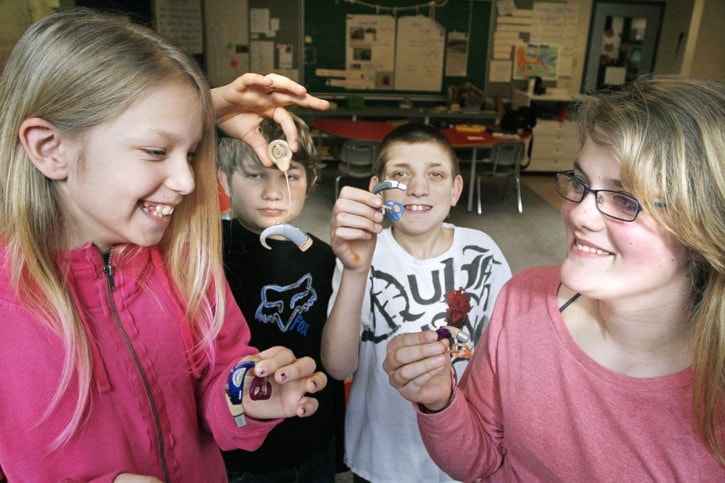For children with severe hearing loss, David Cameron elementary can be a haven.
“When I was the only one in the school (who was deaf) I stood out like a superstar,”said 11-year-old Echo, whose last name is being withheld. “Being here I feel like a normal person.”
Born deaf, as a toddler Echo received a cochlear implant, an electronic device implanted on the cochlea to act as a bionic ear.
It’s not uncommon for deaf children to be the only child with a hearing aid in a school. David Cameron in Colwood has seven children who are profoundly hard of hearing.
These children attend regular classes with their hearing schoolmates, but have additional support with a full-time teacher-of-the-deaf and an interpreter.
Home to the District Resource Program for the Deaf and Hard of Hearing, David Cameron school was renovated in 1994 and designed specifically to cater to the needs of deaf and hearing impaired children.
The school hallways and classrooms are carpeted to muffle sounds — dropped pens and chair legs scrapping on the floor, sounds that can interfere with the use of hearing aids.
It’s the only comprehensive public school program for deaf and hard of hearing students on the Island and one of the few in the province.
With a large contingent of hearing impaired students at the school, David Cameron is able to pool provincial funding alloted for each child to have a full-time teacher-of-the-deaf and a sign-language interpreter.
The teacher-of-the-deaf helps the children learn speech by teaching them to speak clearly and with proper pronunciation. They also focus on skills such as signing, lip reading and finding information.
“I don’t always understand what you are saying, but I can find out because I can read lips,” said 10-year-oldNoah Savage.
Students are also taught slang and pop culture references, because it’s harder for them to pick this up through incidental learning.
“I also help them with multiple word meanings and sayings like ‘pulling your leg,’” said teacher-of-the-deaf Sharon James.
The school has two other teachers trained to teach deaf and hard of hearing students. One teaches grades 1 and 2 and the other is the music teacher. Three of the deaf students are in the split Grade 1 and 2 class being taught full-time by a trained teacher-of-the-deaf.
“They are so lucky to have that,” James remarked.
If a child is the only hearing impaired student in a school, typically they would spend about one hour per week with a teacher-of-the-deaf. In this program the students receive daily interaction.
Having a population of deaf students also helps with creating acceptance and understanding with the other students. Each classroom in the school has a television with daily school announcements and the school’s interpreter Gaye Mcleod, signs the information.
McLeod spends time in the classroom with deaf and hard of hearing students and accompanies them to school sporting events and extracurricular clubs.
When a coach is going over a play on the field, for instance, McLeod is there to make sure the deaf students understand.
“Our goal is to send the kids to middle school being confident and being their own advocates,” McLeod said.
The school also has a FM system, where a speaker wears a small microphone and can projects their voice over radio. Each deaf student has a small attachment on the hearing aid that captures the broadcast and plays it into the ear.
Daisy Makieff, 11, lives in a family with five children, and two of her sisters are hearing impaired.
“Having a sister who is deaf is good because she knows how I feel. She also taught me how to use the FM (system),” Makieff remarked.
Even with the added support the school has to offer, the hearing impaired students just enjoy having other kids around who “get it.”
“Now in a lot of classes there is more than just me with hearing aids. There are other hearing aid kids,” said Fallon Ferguson, 7.
Her condition is called microtia and she was born with her right ear closed. When she is older she may undergo surgery to correct it. She wears a hearing aid attached by a silver headband. Her hearing impairment is what she calls “my angel ear. That’s where the angel kissed me so it stayed closed,” she said.
Lara Krause, 12, moved to Canada from Germany when she was seven years old. Coming to David Cameron was the first time she had been in a school with other deaf kids.
“In Germany I was the only deaf kid (in my school) and I felt very lonely,” Krause said. “Here it feels like there is a family with you.”
reporter@goldstreamgazette.com
